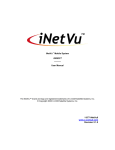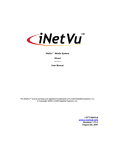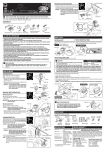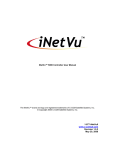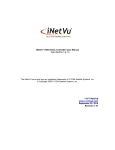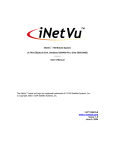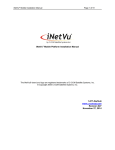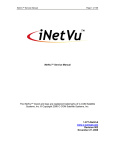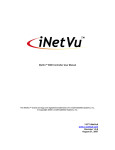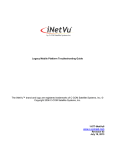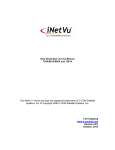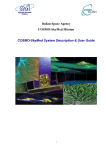Download iNetVu User Manual - Beacon Receiver
Transcript
iNetVu® Mobile System Beacon Receiver User Manual ® The iNetVu brand and logo are registered trademarks of C-COM Satellite Systems, Inc. © Copyright 2006 C-COM Satellite Systems, Inc. 1-877-iNetVu6 www.c-comsat.com Revision 2.1.2 January 15, 2013 iNetVu™ Mobile System User Manual – Beacon Receiver - Preface This page is intentionally left blank. C-Com Satellite Systems Inc Page 2 of 55 iNetVu™ Mobile System User Manual – Beacon Receiver - Preface Page 3 of 55 Table of Contents Chapter 1: Introduction ....................................................................................................7 1.1 About This Manual ...........................................................................................7 1.2 Important Safety Information ............................................................................ 7 1.3 System Overview .............................................................................................8 1.4 iNetVu® Antennae ............................................................................................9 1.5 iNetVu® Mobile Software ................................................................................ 10 1.6 Minimum Computer Requirements................................................................. 10 Chapter 2: Beacon Receiver and the iNetVu® 5000 Controller ..................................... 11 2.1 General .......................................................................................................... 11 2.2 Installation Overview ...................................................................................... 12 2.3 USB / Serial Connection ................................................................................ 13 2.4 Pre-Configuration Checklist ........................................................................... 15 2.5 iNetVu® Mobile System Wiring ...................................................................... 16 2.6 Installing IMS ................................................................................................. 20 2.7 Initial Configuration + Verification Test ........................................................... 23 Chapter 3: Beacon Receiver and the iNetVu® 9000 Controller ..................................... 26 3.1 General .......................................................................................................... 26 3.2 Installation Overview ...................................................................................... 27 3.3 Pre-Configuration Checklist ........................................................................... 28 3.4 iNetVu® Mobile System Wiring ...................................................................... 29 3.5 Initial Configuration + Verification Test ........................................................... 32 Chapter 4: Beacon Receiver and the iNetVu® 7000 Series Controller .......................... 35 4.1 General .......................................................................................................... 35 4.2 Installation Overview ...................................................................................... 36 4.3 Pre-Configuration Checklist ........................................................................... 37 4.4 iNetVu® Mobile System Wiring ....................................................................... 38 4.4.1 Option 1: BR300L Stand Alone (modem free) - USB PC Connection ......... 38 4.4.2 Option 2: BR300L Stand Alone (modem free) – PC Network Connection... 39 4.4.3 Option 3: BR300L with MODEM – PC USB Connection ............................. 40 4.4.4 Option 4: BR300L with MODEM – PC Network Connection ....................... 41 4.5 Setting Up Network Configuration on your PC ............................................... 43 4.6 Initial Configuration with Beacon Receiver ..................................................... 44 Chapter 5: iNetVu® Beacon Receiver Operation ............................................................ 47 5.1 Functional Description ................................................................................... 47 5.2 System Specifications: ................................................................................... 48 5.3 Physical Characteristics: ................................................................................ 49 5.4 Environmental Specifications ......................................................................... 49 5.5 Front Panel Facilities ..................................................................................... 49 5.6 Rear Panel Facilities: ..................................................................................... 52 5.7 Signal Strength Output Circuit ........................................................................ 53 5.8 Remote Operation ......................................................................................... 54 5.9 Serial Communications RS-232 .................................................................... 54 C-Com Satellite Systems Inc iNetVu™ Mobile System User Manual – Beacon Receiver - Preface Page 4 of 55 Copyright © 2006. All rights reserved. C-COM Satellite Systems Inc. This document contains information, which is protected by copyright. All rights reserved. Reproduction, adaptation, or translation without prior written permission is prohibited, except as followed under the copyright laws. ® Both the iNetVu and C-COM names and logos are registered trademarks of C-COM Satellite Systems Inc. ® Intel Pentium is a registered trademark of Intel Corporation. Microsoft, Windows, Windows NT and MapPoint are registered trademarks of Microsoft Corporation. All other product names mentioned in this manual may be trademarks or registered trademarks of their respective companies and are the sole property of their respective manufacturers. C-Com Satellite Systems Inc iNetVu™ Mobile System User Manual – Beacon Receiver - Preface Page 5 of 55 FCC and INDUSTRY CANADA INFORMATION TO THE USER: The FCC and Industry Canada have imposed the following conditions when operating, installing and deploying iNetVu® Mobile Earth Stations and is mandatory for all installations made within the Continental United States and Canada as well as Hawaii, Alaska, Puerto Rico, the U.S. Virgin Islands and other U.S. Territories. The FCC requires that a certified installer perform the installation. It is also strongly recommended that a qualified professional RV dealer/installer mount the system on your vehicle. These conditions are also required by C-COM for all other installed locations. All iNetVu® Mobile earth station installers must be C-COM Certified, and must have specifically acknowledged the requirements for iNetVu® Mobile installations, which are as follows: 1. “Installation” is the physical mounting and wiring of the Satellite provider’s earth station on a vehicle or other stationary site in order to prepare for correct operation. Only Certified C-COM iNetVu installers may perform the installation and removal of an iNetVu® Mobile system. 2. “Deployment” means the raising, pointing and orienting of the earth station to the communicating satellite, every time it is raised from a stowed position for use. The deployment of an iNetVu® Mobile system must only be done by a trained installer or by a consumer using the deployment software. 3. Installers shall install the iNetVu® systems only in locations that are not readily accessible to children and in a manner that prevents human exposure to potential radiation hazards. 4. For large vehicles with roof mounts, the height of the bottom lip of the earth station when fully deployed must be at least six feet above the ground at all times, or six feet above a surrounding surface which a person may easily access. 5. If a roof access ladder or any other means of access to the roof is installed on the vehicle, then the ladder or access must be blocked by a suitable rope or other barrier while the earth station is deployed or in operation. The installer must provide this rope or barrier directly to the end user at the time of installation and advise the user to use it at all times when the earth station is deployed or in operation. Warning signs shall also be provided by the installer to the end user to be posted on the rope or other barrier warning all persons not to attempt to access the roof of the vehicle while the earth station is deployed or in operation. 6. Warning signs shall be posted at prominent locations on the earth station informing all persons of the danger of harmful radiation from the earth station while it is deployed or while in operation. 7. The iNetVu® Mobile system may only be operated when the vehicle is stationary. 8. The installer must inform the end user that the vehicle must be stabilized during the transmission, to prevent movement of the vehicle for any reason, including movement of persons on or off the vehicle, or high winds. The installer shall advise the end user how to appropriately stabilize their vehicle. 9. Installers shall be liable for all damages if they fail to comply with the above mandatory conditions. This includes, but is not limited to damages caused by improper installation or due to the failure to provide required information to the end user. 10. Installers and end users will be deemed directly liable for any damages resulting from either of their failure to comply with the above rules. These rules are meant C-Com Satellite Systems Inc iNetVu™ Mobile System User Manual – Beacon Receiver - Preface Page 6 of 55 to ensure that extraordinary precautions and measures are used to prevent satellite interference or exposure to harmful radiation. C-COM reserves the rights to immediately suspend without liability or previous notice the operation of the earth station upon detection of a deviation from its installation or operational requirements until the deviation is corrected. In addition, C-COM reserves the right to suspend or cancel the Installer Certificate of any installer that has not fully complied with these installation requirements. 11. Further, the installer and end user may be directly liable for any damages resulting from any change undertaken by either of them. Including but not limited to, any modification of any part of the hardware, software, specific operational frequencies, the authorized satellite, or the size or other characteristics of the earth station supplied to them by C-COM or C-COM’s authorized representatives. Note 1: This equipment has been tested and found to comply with the limits for a Class B digital device, pursuant to Part 15 of FCC rules. These limits are designed to provide reasonable protection against harmful interference when the equipment is operated in a residential installation. This equipment generates, uses, and can radiate radio frequency energy and, if not installed and used in accordance with this instruction manual, may cause harmful interference with radio communications. However, there is no guarantee that interference will not occur in a particular installation. If this equipment does cause harmful interference to radio or television reception, which can be determined by turning the equipment off and on, the user is encouraged to try to correct the interference by one or more of the following measures: • Reorient or relocate the receiving antenna. • Increase the separation between the equipment and receiver. • Connect the equipment into an outlet on a circuit different from that to which the receiver is connected. • Consult the dealer or an experienced radio / TV technician for help. Note 2: This Class B digital apparatus complies with Canadian ICES-003. C-Com Satellite Systems Inc iNetVu™ Mobile System User Manual – Beacon Receiver - Preface Page 7 of 55 Chapter 1: Introduction 1.1 About This Manual This manual outlines the steps and procedures involved in the setup and configuration of the iNetVu® System with a Beacon Receiver. An electronic version of this manual is included on the iNetVu® CD that came with your system. It is broadly organized into four (4) main chapters: 1. 2. 3. 4. 5. Introduction Beacon Receiver and the iNetVu® 5000 Controller Beacon Receiver and the iNetVu® 9000 Controller Beacon Receiver and the iNetVu® 7000 Controller Beacon Receiver Operation 1.2 Important Safety Information For your safety and protection, read this entire manual before attempting to install or use the iNetVu® Mobile System. Keep this manual where you can refer to it if necessary. Types of Warnings Used in This Manual This section introduces the various types of warnings used in this manual to alert you to possible safety hazards. Indicates an imminently hazardous situation, which, if not avoided, will result in death or serious injury. Indicates a potentially hazardous situation, which, if not avoided, could result in death or serious injury. C-Com Satellite Systems Inc Indicates a potentially hazardous situation, which, if not avoided, may result in minor or moderate injury. Indicates a situation or practice that might result in property or equipment damage. 1.3 System Overview The iNetVu® Mobile Satellite Internet system is an automatic scanner, polarizer and beam positioning system for a foldable two-way satellite antenna. It has been designed to automatically find and acquire the satellite beam and the position based on both a GPS position reading as well as other positioning parameters. It is targeted for mobile users that require high speed Internet access in remote locations where cable and DSL do not exist. It provides two-way, high-speed data communications over satellite. iNetVu® empowers mobile users with the ability to stop anywhere there is Satellite coverage and access Internet at broadband speeds. The mobile system offers the following additional capabilities and features: • Mobile Platform features a 3-axis DC motor drive system • Elevation system features a highly reliable linear actuator to control elevation • All drive components are high strength steel, housed in lubricated housings, which results in a rigid, highly reliable, system with the minimum of weight • Reflector is an offset, prime focus, SMC high strength plastic illuminated by a corrugated horn • Satellite acquisition and lock in less than 5 minutes (under normal circumstances) • Satellite independent – compatible with any configured satellite • Dish pointing is automatic and fully software controlled • Optimized signal reception and transmission • Fast re-acquisition based on last good position • Interfaces with a full-function controller with features such as automatic stowing, GPS and flux-gate compass and automatic satellite pointing • Reliable acquiring, minimal maintenance • Self-calibrating and tuning after satellite acquisition C-Com Satellite Systems Inc 1.4 iNetVu® Antenna The iNetVu® 1800, 1500, 1200 and 980 Antenna are circular 1.8m, 1.5m, 1.2m and 0.98m (respectively) two-way Ku-Band satellite dish mounted over an arm that supports the antenna, Radio Transmitter and Low Noise Block (LNB). Additionally, the iNetVu® 1800/1500 Mobile Platform can be configured for C Band. The iNetVu® 950, 750, 740 Antenna are elliptical 0.95m, 0.75m, 0.74m (respectively) two-way Ku-Band satellite dishes mounted over an arm that supports the antenna plus the Radio Transmitter and the Low Noise Block (LNB). iNetVu® New Generation Antenna The iNetVu® 1201 and 981 Drive-Away Antenna system is a sleek, simple to operate 1.2m and 0.98m (respectively) auto-deploy VSAT terminal which can be mounted on the roof of a vehicle. The system works seamlessly with sophisticated integral sensors and the iNetVu® 7024C Controller to ensure excellent pointing accuracy. The iNetVu® Ka-75V, Ka-98V, Ka98G, Ka98H, Drive-Away Antenna is a 75cm and 98cm (respectively) auto-acquire satellite antenna system which can be mounted on the roof of a vehicle for direct broadband access over any configured satellite. The system works seamlessly with the iNetVu® 7024C Controller providing fast satellite acquisition within minutes, anytime anywhere. C-Com Satellite Systems Inc 1.5 iNetVu® Mobile Software The iNetVu® Mobile application consists of the iNetVu® Mobile software iNetVu® Mobile Application Key Features: • Automatic re-peak on satellite upon signal loss. • Automatic dish stow if Mobile Platform moves • If the vehicle is moved before the dish is stowed, the dish will sense movement and will automatically begin stowing itself. • The dish will not transmit unless it is pointed adequately to meet crosspolarization specifications. • The system will automatically find any satellite from any point on the Earth within its coverage area. • Displays comprehensive information about the satellite, dish, motors, GPS, compass, control box, and modem/tuner/beacon receiver. • Finds the satellite, peaks the signal strength and selects the optimal path to perform the selected satellite, allowing the customer’s computer to be online as soon as possible • Ability to calibrate the dish and download new software and firmware updates. • Simple to install, configure and operate. 1.6 Minimum Computer Requirements • • • • • • • Intel® Pentium® II 400 or higher. Microsoft Windows® 98 SE, Windows® ME, Windows® 2000, Windows® XP or later. RAM: 64MB minimum for Microsoft Windows 98 SE and Windows ME, 128 MB for Windows 2000 or Windows XP (other programs running simultaneously may require additional memory). CD ROM drive. An available USB or serial port for iNetVu® 5000/7000 Controller. Super VGA (800 x 600) or higher monitor with 256 or more colors Microsoft® Mouse or compatible pointing device iNetVu Mobile 7000 Software Operating System Windows XP, Vista, or W7 CPU 2.0 GHZ Memory (RAM) 1.0GB .Net Framework 3.5 installed Admin level user privileges C-Com Satellite Systems Inc iNetVu™ Mobile System User Manual – Beacon Receiver Page 11 of 55 Chapter 2: Beacon Receiver and the iNetVu® 5000 Controller 2.1 General All iNetVu® Mobile Systems have been fully tested with the iNetVu ® 5000 Controller prior to shipment. All position feedback; limit sensing, limit switches and motor speeds have been calibrated and preset prior to shipping. The wave-guide, the boom mounted Radio Transmitter cables and the Transmission/Receive coaxial cables have all prewired. There is no need to re-calibrate the Mobile Platform unless directed by a C-Com Support Technician. It is critical that the iNetVu® Controller stay together with the Mobile Platform it shipped with. You may refer to the iNetVu® Shipping Checklist to confirm this. The iNetVu® Mobile System has been designed for either roof rack mounting or mounting directly to a vehicle. The iNetVu ® Mobile Platform should always be secured to the vehicle. C-Com Satellite Systems Inc iNetVu™ Mobile System User Manual – Beacon Receiver Page 12 of 55 2.2 Installation Overview a. Unpack the Mobile Platform and reflector. b. Attach reflector to Mobile Platform (iNetVu® 1200 / 1800 Mobile System only). c. Locate a suitable mounting site with adequate clearance. d. For Direct Roof Installation: I. Mark the position of the Mobile Platform ensuring the front / back orientation is correct. II. Pre-seal the roof. III. Place the Mobile Platform in position. IV. Drill pilot holes if necessary and secure with screws. Note that the dish may obscure some of the mounting holes. V. Install the corner screws. VI. Raise the dish either via Handheld Controller, or iNetVu® Mobile Software. VII. Attach Mobile Platform to roof. For Thule Rack Installation: i. Attach Mobile Platform to Thule Rack e. Run Power, Motor Control, Coaxial, Sensor cables. f. Connect iNetVu® Controller, Beacon Receiver, DB-9 Serial Cable, PC and Mobile Platform. g. Verify IMS, iNetVu® Controller firmware and Beacon Receiver Firmware versions for compatibility. h. Install IMS (iNetVu® Mobile Software). i. Power on PC, DuraComm® LP-18 Power Supply, iNetVu® Controller, and Beacon Receiver. j. Start and configure IMS. k. Conduct iNetVu® System Verification Test. C-Com Satellite Systems Inc iNetVu™ Mobile System User Manual – Beacon Receiver Page 13 of 55 2.3 USB / Serial Connection There are two options for connecting the iNetVu® 5000 Controller to the PC: • • USB Connection DB9 Serial Port Connection The user should make their decision based on the available ports on the PC that will be used, as well as the distance the iNetVu® 5000 Controller will be from the PC. The iNetVu® 5000 Controller supports USB 2.0 and USB 1.1 with backwards compatibility, and runs at 480Mbps and 12Mbps, respectively. Serial Port communication offers a greater range in distance. The iNetVu® Mobile System has been tested for 25’ (7620mm) Serial cable connections and 6’ (1829mm) USB connections. Note: iNetVu® 9000 Controller Users DO NOT need to set the communication between your PC and Controller. Serial Connection Connect the serial cable from the COM port on the iNetVu® 5000 controller to a free COM port on the PC. USB Connection 1. Ensure the iNetVu® CD is in the CD-ROM drive. If the Auto-run menu appears please click Exit. Connect the USB cable from the USB port on the iNetVu® 5000 Controller to a free USB Port on the PC. If the iNetVu® 5000 Controller is powered, the PC will detect the new hardware. 2. The New Hardware Wizard will start. Select Install from a list or specific location (Advanced), and click Next. C-Com Satellite Systems Inc iNetVu™ Mobile System User Manual – Beacon Receiver Page 14 of 55 3. Select Search for the best driver in these locations, and check Include this location in the search. 4. Click browse and navigate to the driver folder on the iNetVu® CD, and click Next. 5. Should the following window appear, click Continue Anyway. 6. Congratulations! The USB driver for the iNetVu® 5000 Controller has been installed successfully. C-Com Satellite Systems Inc iNetVu™ Mobile System User Manual – Beacon Receiver Page 15 of 55 2.4 Pre-Configuration Checklist The following items should be completed/known prior to configuring the iNetVu® Mobile System. • Satellite Longitude • Beacon Frequency • Receive and Transmit Polarization • PLL LNB – 5KHz Accuracy or better • Ensure iNetVu Beacon Receiver is set to “REMOTE MODE” To place the unit in the REM (remote) mode of operation by depressing and holding the LOC/REM button and depressing and releasing the RESET button. The unit will toggle between the LOCAL and REMOTE mode of operation. When the REMOTE mode is selected, REM will be displayed in the lower left corner of the front panel display. C-Com Satellite Systems Inc iNetVu™ Mobile System User Manual – Beacon Receiver Page 16 of 55 2.5 iNetVu® Mobile System Wiring iNetVu™ Mobile Platform GPS Antenna MOTOR CONTROL SENSOR RX TX TX SOURCE RX IN Power Pass 12 VDC USB Cable DB9 Male to Female Serial Cable RX IN Computer Motor Control Cable Sensor Cable ! 100 – 240 VAC RG6 Coaxial Cable Network Cable Power Cable Fig. 1: ® iNetVu System Wiring Diagram with Beacon Receiver C-Com Satellite Systems Inc iNetVu™ Mobile System User Manual – Beacon Receiver Fig. 2: Page 17 of 55 From left to right: Sensor Cable, Motor Control Cable, Tx and Rx RG6 Coaxial Cables C-Com Satellite Systems Inc iNetVu™ Mobile System User Manual – Beacon Receiver Page 18 of 55 Procedure 1. Unpack the iNetVu® Controller, DuraComm® LP-18 Power Supply, and all cables included with the iNetVu® Mobile System. 2. Ensure the power switch on the DuraComm® LP-18 Power Supply is turned off. 3. Connect GPS Antenna to the iNetVu® Controller, and place in a position away from the iNetVu® Mobile Platform where it has a clear “view” of the sky. 4. Connect the 12VDC Power Cable to the DuraComm® LP-18 Power Supply and iNetVu® Controller. At one end of the power cable, there are 2 clearly marked wires. Connect the wire marked “+12VDC” to the positive (red) terminal and the other to the negative (black) terminal. Connect the DuraComm® LP-18 Power Supply to an available AC power outlet. Fig. 3: Connecting 12VDC Power Cable to DuraComm® LP-18 Power Supply 5. Connect USB Cable from iNetVu® Controller to your PC. 6. Connect Sensor Cable (DB26) and Motor Control Cable (8-pin Terminator Block) to the iNetVu® Controller. 7. Connect the “Tx” and “Rx” labeled RG6 Coaxial Cable to the Mobile Platform Connectors labeled “Tx” and “Rx”. 8. Connect the free end of the “Tx” labeled RG6 Coaxial Cable to the Transmit Source. 9. Connect the free end of the “Rx” labeled RG6 Coaxial Cable to the RF-Splitter. C-Com Satellite Systems Inc iNetVu™ Mobile System User Manual – Beacon Receiver Page 19 of 55 10. Connect the RG6 Coaxial Cables leading from the RF-Splitters. The line on the label of the RF-Splitters denotes DC continuity, which must be connected to the Beacon Receiver. Ensure that you do not reverse the RG6 Coaxial Cable connections to the iNetVu® Controller and the Beacon Receiver. 11. Connect the Male to Female DB9 Serial Cable from the Beacon Receiver to the PC. 12. Connect the Sensor Cable and Motor Control Cable to the Mobile Platform Connectors. These cable connectors are keyed and will only be connected properly when the key is matched to fit the groove, and you are able to tighten the locking ring. 13. Congratulations! The iNetVu® Mobile System wiring has been successfully completed. C-Com Satellite Systems Inc iNetVu™ Mobile System User Manual – Beacon Receiver Page 20 of 55 2.6 Installing IMS The iNetVu® Mobile Software CD will initiate an auto-run when inserted into your CDROM Drive. Follow the instructions below to help you install IMS. Note: The iNetVu® 9000 Controller is shipped with IMS installed and configured. Users will not have to perform an installation of IMS, unless otherwise instructed to by a C-Com Satellite Systems Technician for upgrades, patches, etc. 1. Insert the iNetVu ® Mobile Software CD into the CD-ROM drive of the PC. If the CD does not initiate auto-run, click on My Computer, and select the CDROM. Double click iNetVuSetupMenu.exe 2. Select “Install iNetVu Mobile Beacon Receiver Edition” 3. The Setup Wizard will start. Click Next to continue. Fig. 4: Setup Wizard Start-up Screen 4. Click Next to continue. C-Com Satellite Systems Inc iNetVu™ Mobile System User Manual – Beacon Receiver Page 21 of 55 Fig. 5: Setup Wizard Start-up screen 5. Select your Installation folder and choose the availability of iNetVu® Mobile between Everyone and Just Me. Fig. 6: Installation Folder Selection 6. Confirm the installation by clicking Next. Fig. 7: 7. Setup Wizard will iNetVu® Mobile. now install C-Com Satellite Systems Inc Installation Confirmation iNetVu™ Mobile System User Manual – Beacon Receiver Fig. 8: Page 22 of 55 Installing iNetVu Mobile 5000 8. Congratulations! iNetVu® Mobile software has been successfully installed. Fig. 9: Installation Complete Note: If you are using a Firewall, ensure that you add the iNetVu® Mobile Software to the “allowed/unblocked” list. C-Com Satellite Systems Inc iNetVu™ Mobile System User Manual – Beacon Receiver Page 23 of 55 2.7 Initial Configuration + Verification Test Once IMS is installed onto your PC, you are required to configure the system parameters for the following: • • • • Communication Method between IMS and iNetVu® Controller Satellite Name, Longitude, and Transmit Polarization Beacon Receiver Communication Parameters Contact Email Address Fig. 10: Initial Configuration Screen 1. Select the method of communication with the Controller by selecting USB Port or Serial Port. 2. Enter the Satellite Name, Longitude, and Transmit Polarization. Note: If you are using an iNetVu® 950/980 Mobile Platform, ensure that the OMT-TRF is positioned in the appropriate orientation for the Transmit Polarization required. Refer to the Platform Setup and Maintenance Manual for details on how to switch polarity on the OMT-TRF. C-Com Satellite Systems Inc iNetVu™ Mobile System User Manual – Beacon Receiver Page 24 of 55 3. Select Beacon as the Beacon Receiver Type 4. Enter the Beacon Frequency in the Satellite Frequency Text Field. 5. Ensure COM1 and a Baud Rate of 2400 is selected. 6. Enter an email address. (This is used for Contact Purposes Only). 7. Click OK, and confirm your configuration. 8. iNetVu® Mobile will start and a red iNetVu® “swirl” icon will appear in the System tray at the bottom right of the Windows Desktop taskbar 9. Right-click the red iNetVu® “swirl” icon and select Configuration. Fig. 11: Configuration Menu 10. Verify USB/Serial, and Beacon Receiver Communication settings and the contact email address. 11. Enter an IP address or Web Address in the Test Site or IP field. This test address will be “pinged” by IMS to ensure connectivity after you are connected to the network. 12. Right-click the iNetVu® icon and select Advanced Controls. C-Com Satellite Systems Inc iNetVu™ Mobile System User Manual – Beacon Receiver Page 25 of 55 13. Verify that all the Status Panel Indicators are green, and not flashing red. If there are any flashing red indicators on the Status Panel, trouble-shoot those before moving forward. 14. Click Find Satellite located in Automatic Control. Find Satellite Fig. 12: Stow Antenna Stop Operation Automatic Control Buttons 15. Observe the iNetVu® Mobile Platform. If everything has been installed correctly, the Mobile Platform will rise up from its stowed position. Note: At any time, the Stop Operation may be used. Clicking this button will stop all movement. 16. The iNetVu® Mobile Platform will raise itself and acquire the compass heading from the compass, then point itself to the calculated target coordinates. 17. The iNetVu® Mobile Platform begin its search pattern within the search window and will lock onto satellite within 3 to 5 minutes assuming there are no obstructions in its view of the satellite. 18. The signal strength indicator will turn green, and the Isolation Value Indicator will turn blue. 19. When the peaking process is completed, click Target Calibrate only need to be done once. . This will 20. Click Stow Dish located in Automatic Control to return the dish to its stowed position. 21. Congratulations! The iNetVu® Mobile System is now ready for use. C-Com Satellite Systems Inc iNetVu™ Mobile System User Manual – Beacon Receiver Page 26 of 55 Chapter 3: Beacon Receiver and the iNetVu® 9000 Controller 3.1 General All iNetVu® Mobile Systems have been fully tested with the iNetVu ® 9000 Controller prior to shipment. All position feedback; limit sensing, limit switches and motor speeds have been calibrated and preset prior to shipping. The wave-guide, the boom mounted Radio Transmitter cables and the Transmission/Receive coaxial cables have all prewired. There is no need to re-calibrate the Mobile Platform unless directed by a C-Com Support Technician. It is critical that the iNetVu® Controller stay together with the Mobile Platform it shipped with. You may refer to the iNetVu® Shipping Checklist to confirm this. The iNetVu® Mobile System has been designed for either roof rack mounting or mounting directly to a vehicle. The iNetVu ® Mobile Platform should always be secured to the vehicle. C-Com Satellite Systems Inc iNetVu™ Mobile System User Manual – Beacon Receiver Page 27 of 55 3.2 Installation Overview 1. Unpack the Mobile Platform and reflector. 2. Attach reflector to Mobile Platform (iNetVu® 1200/1800 Mobile Systems only – see Platform Setup and Maintenance Manual for installation instructions) 3. Locate a suitable mounting site with adequate clearance. 4. For Receiver Roof Installation: (See Platform Setup and Maintenance Manual for Detail) I. Mark the position of the Mobile Platform ensuring the front / back orientation is correct. II. Pre-seal the roof. III. Place the Mobile Platform in position. IV. Drill pilot holes if necessary and secure with screws. Note that the dish may obscure some of the mounting holes. V. Install the corner screws. VI. Raise the dish either via Handheld Controller, iNetVu® Mobile software, or the 9000 Controller front panel. VII. Attach Mobile Platform to roof. 5. For Thule Rack Installation: (See Platform Setup and Maintenance Manual for Detail) ii. Attach Mobile Platform to Thule Rack 6. Run Power, Motor Control, Coaxial, Sensor cables. 7. Connect iNetVu® Controller, Beacon Receiver, and Mobile Platform. 8. Power on the iNetVu® Controller, and Beacon Receiver. 9. Verify IMS, iNetVu® Controller firmware and Beacon Receiver firmware versions for compatibility. 10. Determine the receive polarization, as well as the beacon frequency 11. Start and configure IMS. 12. Conduct iNetVu® System Verification Test. C-Com Satellite Systems Inc iNetVu™ Mobile System User Manual – Beacon Receiver Page 28 of 55 3.3 Pre-Configuration Checklist The following items should be completed/known prior to configuring the iNetVu® Mobile System. • Satellite Name and Coordinate • Beacon Frequency • Transmit and Receive Polarization (Horizontal/Vertical) • PLL LNB – 5KHz Accuracy or better • Ensure iNetVu Beacon Receiver is set to “REMOTE MODE” To place the unit in the REM (remote) mode of operation by depressing and holding the LOC/REM button and depressing and releasing the RESET button. The unit will toggle between the LOCAL and REMOTE mode of operation. When the REMOTE mode is selected, REM will be displayed in the lower left corner of the front panel display. C-Com Satellite Systems Inc iNetVu™ Mobile System User Manual – Beacon Receiver Page 29 of 55 3.4 iNetVu® Mobile System Wiring iNetVu™ Mobile Platform GPS Antenna SENSOR RX TX TX SOURCE RX IN Power Pass MOTOR CONTROL IP: 192.168.0.1 SUB: 255.255.255.0 GW: 192.168.0.1 DB9 Male to Female Serial Cable ! 100 – 240 VAC IP: 192.168.0.2 SUB: 255.255.255.0 GW: 192.168.0.1 RX IN Computer Note: A PC could be used to access the 9000 web interface if necessary to set the beacon frequency or troubleshoot. A PC could communicate with the 9000 Controller behind a router as long as they are on the same network. (See 9000 controller manual for details) Fig. 13: Motor Control Cable Sensor Cable ! 100 – 240 VAC RG6 Coaxial Cable Network Cable Power Cable System Wiring Diagram for Beacon Receiver and 9000 Controller C-Com Satellite Systems Inc iNetVu™ Mobile System User Manual – Beacon Receiver Fig. 14: Page 30 of 55 From left to right: Sensor Cable, Motor Control Cable, Tx and Rx RG6 Coaxial Cables C-Com Satellite Systems Inc iNetVu™ Mobile System User Manual – Beacon Receiver Page 31 of 55 Procedure 1. Unpack iNetVu® 9000 Controller, and all cables included with the iNetVu® Mobile System. 2. Connect GPS Antenna to the iNetVu® Controller, and place in a position away from the iNetVu® Mobile Platform where it has a clear “view” of the sky. 3. Connect the Power Cable to the back panel of the iNetVu® 9000 Controller. 4. Connect Sensor Cable (DB26) and Motor Control Cable to the iNetVu® Controller. 5. Connect the “Tx” and “Rx” labeled RG6 Coaxial Cable to the Mobile Platform Connectors labeled “Tx” and “Rx”. 6. Connect the free end of the “Tx” labeled RG6 Coaxial Cable to the Transmit Source. 7. Connect the free end of the “Rx” labeled RG6 Coaxial Cable to the RF-Splitter. 8. Connect the RG6 Coaxial Cables leading from the RF-Splitters. The line on the label of the RF-Splitters denotes DC continuity, which must be connected to the iNetVu® Beacon Receiver. Ensure that you do not reverse the RG6 Coaxial Cable connections to the iNetVu® Controller and the Beacon Receiver. 9. Connect the 12 V power supply to the Beacon Receiver. 10. Connect the Male to Female DB9 Serial Cable from the Beacon Receiver to the iNetVu® 9000 Controller. 11. Connect the Sensor Cable and Motor Control Cable to the Mobile Platform Connectors. These cable connectors are keyed and will only be connected properly when the key is matched to fit the groove, and you are able to tighten the locking ring. 12. Congratulations! The iNetVu® Mobile System wiring has been successfully completed. C-Com Satellite Systems Inc iNetVu™ Mobile System User Manual – Beacon Receiver Page 32 of 55 3.5 Initial Configuration + Verification Test You are required to configure the system parameters for the following: • • • • Communication Method between IMS and iNetVu® Controller. Satellite Name, Longitude, Transmit and Receive Polarization Beacon Frequency Contact Email Address 1. Access the web interface of the iNetVu® 9000 Controller. (See 9000 Manual for details) 2. Advance to the maintenance menu, and enter the Satellite Name, and Longitude. Click the ‘Save’ button when complete. Fig. 15: Web Interface – Maintenance Screen C-Com Satellite Systems Inc iNetVu™ Mobile System User Manual – Beacon Receiver Page 33 of 55 3. Advance to the Configuration menu and modify/ensure the correct Beacon Frequency; COM port (COM1), and Baud Rate (2400) are set. Note: If you are using an iNetVu® 950/980 Mobile Platform, ensure that the OMT-TRF is positioned in the appropriate orientation for the Transmit Polarization required. See Mobile Installation Manual for details. 4. Enter an email address. (This is used for Contact Purposes Only). 5. Click Save, and confirm your configuration. 6. Advance to the Controls screen, Verify that all the Status Panel Indicators are green, and not flashing red. If there are any flashing red indicators on the Status Panel, trouble-shoot those before moving forward. 7. Click Find Satellite located in Automatic Control. Fig. 16: Automatic Control Buttons C-Com Satellite Systems Inc iNetVu™ Mobile System User Manual – Beacon Receiver Page 34 of 55 8. Observe the iNetVu® Mobile Platform. If everything has been installed correctly, the Mobile Platform will rise up from its stowed position. Note: At any time, the Stop Operation may be used. Clicking this button will stop all movement. 9. The iNetVu® Mobile Platform will raise itself and acquire the compass heading from the compass, then point itself to the calculated target coordinates. 10. The iNetVu® Mobile Platform begin its search pattern within the search window and will lock onto satellite within 3 to 5 minutes assuming there are no obstructions in its view of the satellite. 11. Once the iNetVu® Mobile Platform has locked on to the satellite and finished its peaking process, you will be notified the process has been completed. 12. Click Target . This will calibrate the elevation offset for any unequal grounds. This process only needs to be done once. 13. Click Stow Dish located in Automatic Control to return the dish to its stowed position. 14. Congratulations! The iNetVu® Mobile System is now ready for use. C-Com Satellite Systems Inc iNetVu™ Mobile System User Manual – Beacon Receiver Page 35 of 55 Chapter 4: Beacon Receiver and the iNetVu® 7000 Series Controller 4.1 General All iNetVu® Mobile Systems have been fully tested with the iNetVu® 7000 Controller prior to shipment. All position feedback; limit sensing, limit switches and motor speeds have been calibrated and preset prior to shipping. The wave-guide, the boom mounted Radio Transmitter cables and the Transmission/Receive coaxial cables have all pre-wired. There is no need to re-calibrate the Mobile Platform unless directed by a C-Com Support Technician. It is critical that the iNetVu® Controller stay together with the Mobile Platform it shipped with. You may refer to the iNetVu® Shipping Checklist to confirm this. The iNetVu® Mobile System has been designed for either roof rack mounting or mounting directly to a vehicle. The iNetVu® Mobile Platform should always be secured to the vehicle. C-Com Satellite Systems Inc iNetVu™ Mobile System User Manual – Beacon Receiver Page 36 of 55 4.2 Installation Overview 1. Unpack the Mobile Platform and reflector. 2. Attach reflector to Mobile Platform if necessary (For iNetVu® 1200/1500/1800 Mobile Systems only – See Mobile Platform Installation Manual) 3. Locate a suitable mounting site with adequate clearance. 4. For Receiver Roof Installation: (See Mobile Platform Installation Manual for details) a. Mark the position of the Mobile Platform ensuring the front / back orientation is correct. b. Pre-seal the roof. c. Place the Mobile Platform in position. d. Drill pilot holes if necessary and secure with screws. Note that the dish may obscure some of the mounting holes. e. Install the corner screws. f. Raise the dish either via Handheld Controller, iNetVu® Mobile software, or the Controller front panel. g. Attach Mobile Platform to roof. 5. For Thule Rack Installation: (See Mobile Platform Installation Manual for Detail) • Attach Mobile Platform to Thule Rack 6. Run Power, Motor Control, Coaxial, Sensor cables. 7. Connect iNetVu® Controller, Beacon Receiver, and Mobile Platform. 8. Power on the iNetVu® Controller, and Beacon Receiver. 9. Verify IMS, iNetVu® Controller firmware and Beacon Receiver firmware versions for compatibility. 10. Determine the receive polarization, as well as the beacon frequency. 11. Start and configure IMS. 12. Conduct iNetVu® System Verification Test. C-Com Satellite Systems Inc iNetVu™ Mobile System User Manual – Beacon Receiver Page 37 of 55 4.3 Pre-Configuration Checklist The following items should be completed/known prior to configuring the iNetVu® Mobile System. • Satellite Name and Coordinate • Beacon Frequency • Transmit and Receive Polarization (Horizontal/Vertical) • PLL LNB – 5KHz Accuracy or better • Ensure the switch next to J1 on the back of the iNetVu® BR300L is set to RS-232. • Ensure to attach the null modem adapter, to the 7000 Controller DB9 port. • Ensure iNetVu Beacon Receiver is set to “REMOTE MODE” To place the unit in the REM (remote) mode of operation by depressing and holding the LOC/REM button and depressing and releasing the RESET button. The unit will toggle between the LOCAL and REMOTE mode of operation. When the REMOTE mode is selected, REM will be displayed in the lower left corner of the front panel display. C-Com Satellite Systems Inc iNetVu™ Mobile System User Manual – Beacon Receiver Page 38 of 55 4.4 iNetVu® Mobile System Wiring 4.4.1 Option 1: BR300L Stand Alone (modem free) - USB PC Connection iNetVu™ Mobile Platform GPS Antenna RX TX Sensor Cable TX Source RX *Ground protection Power Pass Motor Cable 24 VDC Input (option) USB Cable ! DB9 Male to Female Serial Cable (Ensure NULL modem adapter is attached to cable or controller) The Power to the LNB may be sent from the Beacon Receiver. Ensure LNB Power Switch is turned ON, and 7000 Controller LNB Power is disabled 90 - 264 VAC RX IN Computer Motor Control Cable ! 90 - 264 VAC Sensor Cable RG6 Coaxial Cable USB Cable Power Cable Fig. 17: Beacon Receiver and 7000 Controller – Stand Alone USB Connection C-Com Satellite Systems Inc iNetVu™ Mobile System User Manual – Beacon Receiver Page 39 of 55 4.4.2 Option 2: BR300L Stand Alone (modem free) – PC Network Connection iNetVu™ Mobile Platform GPS Antenna RX TX Sensor Cable TX Source RX Power Pass *Ground protection Motor Cable 24 VDC Input (option) The Power to the LNB may be sent from the Beacon Receiver. Ensure LNB Power Switch is turned ON, and 7000 Controller LNB Power is disabled Controller IP 192.168.0.3 SUB: 255.255.255.0 Network Cable ! IP: 192.168.0.3 SUB: 255.255.255.0 GW: 192.168.0.2 Note: The Software Application (The same one used to communicate with the USB) or the web interface could be used to communicate with the controller over the network DB9 Male to Female Serial Cable (Ensure NULL modem adapter is attached to cable or controller) ! 90 - 264 VAC RX IN Motor Control Cable Sensor Cable 90 - 264 VAC RG6 Coaxial Cable Network Cable Power Cable Fig. 18: Beacon Receiver and 7000 Controller – Stand Alone Network Connection C-Com Satellite Systems Inc iNetVu™ Mobile System User Manual – Beacon Receiver Page 40 of 55 4.4.3 Option 3: BR300L with MODEM – PC USB Connection iNetVu™ Mobile Platform Motor Control Cable Sensor Cable GPS Antenna RG6 Coaxial Cable Network Cable Sensor Cable Motor Cable TX RX USB Cable Power Cable LNB should be powered from the 7000 controller *Ground protection 24 VDC Input (option) RX IN RX OUT ! 90 - 264 VAC USB Cable Network Cable DB9 Male to Female Serial Cable (Ensure NULL modem adapter is attached to cable or controller) SAT OUT SAT IN Ensure LNB Power Switch is TURNED OFF on the Beacon Receiver ! 90 - 264 VAC C-Com Satellite Systems Inc iNetVu™ Mobile System User Manual – Beacon Receiver Page 41 of 55 4.4.4 Option 4: BR300L with MODEM – PC Network Connection iNetVu™ Mobile Platform Motor Control Cable Sensor Cable GPS Antenna RG6 Coaxial Cable Network Cable Sensor Cable TX RX USB Cable Power Cable LNB should be powered from the 7000 controller *Ground protection 24 VDC Input (option) Motor Cable RX IN RX OUT A.B.C.D+1 255.255.255.X Network Cable A.B.C.D+2 255.255.255.X ! 90 - 264 VAC SAT OUT DB9 Male to Female Serial Cable (Ensure NULL modem adapter is attached to cable or controller) A.B.C.D 255.255.255.X SAT IN Ensure LNB Power Switch is TURNED OFF on the Beacon Receiver ! 90 - 264 VAC C-Com Satellite Systems Inc iNetVu™ Mobile System User Manual – Beacon Receiver Fig. 19: Fig. 20: Page 42 of 55 From left to right: Motor Cable, Sensor Cable, Tx and Rx RG6 Coaxial Cables New Gen Cabling from left to right: Sensor Cable, Motor Control Cable, Rx and Tx RG6 Coaxial Cables C-Com Satellite Systems Inc iNetVu™ Mobile System User Manual – Beacon Receiver Page 43 of 55 4.5 Setting Up Network Configuration on your PC 1. Power ON your PC/Notebook, 7000 Controller and install the iNetVu® 7000 Mobile Software from the installation CD/USB Drive. For USB interface please install correct USB drivers and skip to step (8). 2. If you are using the network interface to communicate with the 7000 Controller, set the PC/Notebook to the same network as the 7000 Controller. (If you are using the USB interface, you may skip to step (8). 3. Open Network and Sharing Center\Network Connections, right-click your network card, and select Properties. 4. Select Internet Protocol Version 4 (TCP/IPv4) and click Properties. 5. Select Use the following IP address. Set your PC to the same subnet as the 7000 Controller. IP Address: Subnet Mask: Gateway: A.B.C.D+2 255.255.255.0 A.B.C.D (Modem/Router IP) The Gateway is usually the Router IP address. If no router is used, it is usually the VSAT Modem IP Address. Set the DNS IP Addresses if required. C-Com Satellite Systems Inc iNetVu™ Mobile System User Manual – Beacon Receiver Page 44 of 55 4.6 Initial Configuration with Beacon Receiver 6. Set the 7000 Controller to the same network as the PC and VSAT Modem. *Note: The controller IP should be set in the controller through the LCD interface prior to entering it into the software tool for proper PC to Controller Communication through network interface. (USB Interface users may skip this step) To Configure the IP address on the controller, you must navigate to the CONF2 menu using the LCD Interface. (Default password “password”) a. Navigate to the “IP” menu and press the “ENTER” button. b. Press the ‘↑’ button to allow for modification on the C_IP field and set the IP address of the controller. If router/modem IP is A.B.C.D, controller IP could be A.B.C.D+1. Press the “ENTER” button once the change is complete. For example, if the Modem/Router IP is 192.168.0.1 then the controller IP could be set to 192.168.0.2. c. Press the “Exit” button twice to exit out of the configuration menu. When prompted if you would like to save configuration, press the ‘ ↑’ button to select “Y” (yes) and press “Enter”. 7000 IP: Subnet Mask: Gateway: A.B.C.D+1 255.255.255.X (Modem/Router Dependent) A.B.C.D (Router/Modem IP) d. Click the “reset” button on the controller. 7. Run the iNetVu® 7000 Mobile Software from the shortcut located on the desktop. Advance to the “Configuration” screen, by right clicking on the “Controls” screen, and selecting “Configuration”, and enter the controller IP address in the “Controller Configuration” section as depicted in the figure below. USB users may skip this step. Click the “Send All” button once the correct IP address is entered. C-Com Satellite Systems Inc iNetVu™ Mobile System User Manual – Beacon Receiver Page 45 of 55 8. IMS should read all the data in the controller. Once that data is received, in the Target Satellite section enter the Satellite Longitude Send All, and then Offset, once again clicking Send All. If the modem is to be powered by the controller please set the correct LNB Power. Sat Pol Offset: 1.2/1.5/1.8 Receive Horizontal Receive Vertical Offset = 0.0 Offset = 90.0 980/740 Offset = 0.0 all cases (Manual adjustment required) Rx = H Upright OMT Rx = V OMT Parallel to horizon 9. Under the Modem and Beacon Receiver section, set according to your modem specification. Type: Interface: Modem Delay: IP Address: Password: Freq (MHz): Sym (s): RX (Receive Polarity): TX (Transmit Polarity): Hemisphere: Beacon Freq (MHz): ACQ Attenuation (dB): HNS / iDirect / Gilat /NA /etc. (NA is used for modem independent satellite acquisition) Telnet, COM, HTTP, UDP, etc. This delays Controller communication to allow slower modems to catch up. The default setting is 0 Enter the Modem IP Address Modem Password if required Service specific Service specific H (Horizontal Receive), V (Vertical Receive) H (Horizontal Transmit), V (Vertical Transmit) Service specific Beacon Receiver Frequency in MHz Power Level of the signal C-Com Satellite Systems Inc iNetVu™ Mobile System User Manual – Beacon Receiver Page 46 of 55 10. If the user does NOT have a valid DVB carrier, and there is no saved carrier in the 7000 controller (999999 appears as the DVB frequency), from the “Maintenance” screen ensure that “RF Search” is selected for the RF satellite acquisition option. 11. Under the “Controller Configuration” section, enter the following: IP Address: Subnet Mask: Default Gateway: DNS: Controller IP Address Controller Subnet Mask Controller Gateway Disregard If the COM port is going to be used with the Optional BR300L, ensure “BEACON” is selected, and a BAUD rate of 2400 is selected. 12. Click “SEND ALL” and “WRITE EPROM”. This will send all configured parameters to the controller. 13. Congratulations you have successfully configured your iNetVu® System. Navigate to the “Controls” menu, if there are any flashing Red, and Yellow components, stop and troubleshoot. Otherwise, click “Find Satellite”. You should be locked on satellite within 2-5 minutes. 14. When complete, you may click on the “Stow Antenna” button, wait until the antenna is stowed, and power off your 7000 Controller. *For more detailed information on the iNetVu® 7000 Controller Software, refer to the iNetVu® 7000 Controller Manual. C-Com Satellite Systems Inc iNetVu™ Mobile System User Manual – Beacon Receiver Page 47 of 55 Chapter 5: iNetVu® Beacon Receiver Operation 5.1 Functional Description The iNetVu® BR300L is a high performance unit that is designed to real time track the power density of a satellite beacon and output a DC voltage that is linearly proportional to the beacon power. Applications are for antenna step track controlling and uplink power control systems. iNetVu® BR300L Front View iNetVu® BR300L Back View C-Com Satellite Systems Inc iNetVu™ Mobile System User Manual – Beacon Receiver Page 48 of 55 5.2 System Specifications: Input Frequency ........................................................................... 930 to 2300 MHz Pre-detection Bandwidth .............................................................................. 50 kHz Input Level ................................................ -90 dBm, minimum; -30 dBm, maximum For full tracking range capability Frequency Tuning .............................................................................. 10 kHz Steps Frequency Adjust .............................................................. Front Panel or Remotely AFC (1) ....................................................................................................... + 23 kHz Threshold ........................................................................ <45 dB-Hz for acquisition Input Impedance ......................................................................................... 75 Ohm Input Connector ................................. Type F female STD (N-type female optional) Output Impedance ...............................................................100 Ohm, single ended Output Connector .................................................. Terminal plug and BNC Female Tracking Response ........................... 0 to +10 VDC for a 20 dB input level change System Level Adjust .......................................................... 0 to 60 dB, 0.5 dB steps Frequency Stability ................................................................................... + 1.0 ppm Frequency Reference ................................................................... 10 MHz (Internal) Phase Noise ........................................................... > 75 dB-Hz, 1 kHz from Carrier Alarms ....................................................................................................... Unit Lock Alarm Relay .................................................................................................. Form-C LNB Voltage .......................... +18VDC, Switchable from rear panel, 300 ma, max. M & C .............................................................RS-232, Switchable, from rear panel M & C Connector ................................................................................ DB-9, Female Streaming ........................................................................ DB-9, Female, (optional) Ethernet Interface ................................................................. RJ-45 Jack (optional) C-Com Satellite Systems Inc iNetVu™ Mobile System User Manual – Beacon Receiver Page 49 of 55 5.3 Physical Characteristics: Size .................................................................................... 1.75 “H X 16”D X 19”W Weight ................................................................................................ 8 lb. (3.63 kg) Primary Power ............................................................ 90-264VAC 47 – 63Hz, 1.4A 5.4 Environmental Specifications Tested in accordance with MIL-STD-2164 0 0 Operating Temperature ........................................................................ 0 c to +50 c 0 0 Storage Temperature ........................................................................ -40 c to +70 c 0 Humidity ......................................................................................... 95% RH@ 40 c 5.5 Front Panel Facilities RES: LOC/REM: Pressing the RES (Reset) button reboots the unit. The unit will retain the parameters of the previous settings. While depressing and holding the LOC/REM button and depressing and releasing the RES button, the unit will toggle between the local and remote mode of operation. In the local mode all parameters can be controlled from the front panel facilities. The remote M&C is not functional in the LOCAL mode of operation. Local Operation Changing Frequency FSET: The FSET button activates the cursor. When depressed and released the cursors will blink over one of the frequency digits. CURSOR: Depressing and releasing the CURSOR button will cause the cursor to move one frequency digit to the right. When the last digit is reached, the cursor will jump to the first frequency digit. When the desired digit is selected, the value of that digit may be changed. C-Com Satellite Systems Inc iNetVu™ Mobile System User Manual – Beacon Receiver Page 50 of 55 UP: While in the FSET mode, the UP button increases the value of the selected frequency digit. DOWN: While in the FSET mode the DOWN button decreases the value of the selected frequency digit. When the desired frequency is selected depress and release the FSET button. The cursor will no longer be displayed and the unit will be tuned to the desired input frequency. Changing Gain When the unit is in the LOCAL mode of operation, the attenuation of the input signal level can be changed to accommodate the variations in the beacon input signal strength level. The attenuation is displayed in dB from 0 to 60 dB on 0.5 dB steps. Once the unit has been tuned to the proper input frequency and the unit indicates that it has locked to that desired carrier then the signal strength the attenuation can be adjusted to achieve the desired operating signal strength voltage. UP: The UP button increases the value of the attenuation of the unit. The maximum attenuation setting is 60 dB and is adjustable on 0.5 dB increments. DOWN: The DOWN button decreases the value of the attenuation of the unit. The minimum attenuation setting is 0 dB and is adjustable on 0.5 dB increments. Using the above procedure, and when the unit is locked to the desired carrier, adjust the gain such that the front panel signal strength indication displays +7.50 VDC. The unit tracks the input signal strength over a 20 dB range (0.5 V/dB). For a signal strength reading of +7.5 VDC, the unit will track upwards to +10.00 VDC or a +5 dB increase in input signal strength and downwards to 0.00 VDC or a –15 dB decrease in signal strength. The signal strength is not only displayed on the front panel but is also available for interfacing to external devices by utilizing the rear mounted terminal plug. Display The front panel display is a 2 x 20 VFD (vacuum fluorescent display). The display provides operating as well as alarm indication. F: 930.00 to 2300.00 MHz on 10 kHz increments ATTEN: 0 to 60 dB on 0.5 dB steps. REM: Displayed in the lower left corner when the unit is in the REMOTE mode of operation. ALM: Continuously displayed if the unit is not locked to the carrier. The green LOCK front panel LED will not be lighted. C-Com Satellite Systems Inc iNetVu™ Mobile System User Manual – Beacon Receiver SS: Page 51 of 55 The signal strength voltage is displayed in volts DC. The range that is displayed is 0.00 to +9.99 VDC. The normal optimum operating level is +7.50 VDC. C-Com Satellite Systems Inc iNetVu™ Mobile System User Manual – Beacon Receiver Page 52 of 55 5.6 Rear Panel Facilities: J1: RJ-45 (optional) MODE: Selection switch for RS-232 external communication. J2: M&C The monitor and control input is a female DB-9 The pins for the appropriate interface are: connector. RS-232: Pin 2 – Transmit Pin 3 – Receive Pin 5 – Ground TB1: Term. 1: Alarm relay common contact Term. 2: Alarm relay normally open contact Term. 3: Alarm relay normally closed contact Term. 4: AFC voltage. When the unit is locked to the carrier the voltage will be approx.2.00 VDC. Term. 5: Signal Ground Term. 6: Signal strength output voltage (SS) J3: SIGNAL STRENGTH (BNC) The signal strength voltage ranges from 0 to + 10 VDC as a function of input signal level. The voltage slope is 0.5 V/dB over a 20 dB input signal change. S2: LNB Voltage, +18 VDC, 500 ma, max., Switchable In/Out on input connector center conductor. AC RECEPTACLE: 90-264 VAC, 47-63 Hz Input, auto-sensing. Spare fuse compartment within receptacle. C-Com Satellite Systems Inc iNetVu™ Mobile System User Manual – Beacon Receiver Page 53 of 55 5.7 Signal Strength Output Circuit J4: STREAMING (optional) Refer to the attachment to the manual if this option is installed. S2: (Not installed) LNB PWR: +18 VDC, On/Off LNB POWER LED: Red LED that is ON when power is applied to the LNB. J5: INPUT The frequency input range is 930 to 2300 MHz with an input level range of –30 to –90 dBm per beacon carrier. J5 Input: Type-F Female 75 ohm J6 Input: 50 ohm, N-type, female connector, Optional J7 Input: (SMA optional) C-Com Satellite Systems Inc iNetVu™ Mobile System User Manual – Beacon Receiver Page 54 of 55 5.8 Remote Operation Note: The unit must be placed in the remote mode of operation to perform any serial communication functions. Select the interface mode (RS-232) by placing the rear mounted mode switch in the appropriate position. 5.9 Serial Communications RS-232 The unit can be remotely monitored and commanded by use of an RS-232, 2-wire interface. The serial protocol is the same for both modes and is as follows: 2400 Baud, No parity, eight data bits, one stop bit (2400,N,8,1) 1. Place the unit in the REM (remote) mode of operation by depressing and holding the LOC/REM button and depressing and releasing the RESET button. The unit will toggle between the LOCAL and REMOTE mode of operation. When the REMOTE mode is selected, REM will be displayed in the lower left corner of the front panel display. 2. The unit needs to be left in the REM mode of operation for external control of the unit. To poll the unit for operating status, transfer the following sequence: 0<space>0<space>0<space> The unit will respond back with the current operating settings and alarm conditions F=f4f3f2f1.k2,k1, ATT=AT3,AT2 . AT1, SS=v2,v1.m1,m2 Where f4f3f2f1 is the operating frequency in MHz, k2, k1 is the operating frequency in kHz, AT3, AT2, . AT1, is the attenuation setting in dB from 0.0 to 60.0, v2, v1,m1, m2 is the signal strength in volts from 9.99 to 0.00. If an alarm condition exits, the unit is out of lock, and then the signal strength voltage will not be displayed and will be displaced with the word ALARM. To change parameters of the unit transmit the following command string: f4f3f2f1<space>k2k1<space>at3,at2,at1<space> Where f4 is the most significant digit of frequency in MHz, k2 is the most significant digit in kHz, g3 is the most significant digit of gain. The range of frequency is 930.00 to 2300.00 and the range of attenuation is 0 to 600. If a frequency of less than 930 or greater than 2300 and/or an attenuation of greater than 600 or a least significant digit of a number other than 0 or 5 is transmitted then ? will be transmitted back. C-Com Satellite Systems Inc iNetVu™ Mobile System User Manual – Beacon Receiver Page 55 of 55 The address, frequency in MHz and kHz and gain must be simultaneously transmitted. They cannot be transmitted independently. The attenuation of the unit can be changed by transmitting any number from 0 to 600. The least significant digit must either be a 0 or a 5. 0 corresponds to 0.0 dB attenuation and 600 corresponds to 60.0 dB of attenuation. To change the attenuation by 0.5 dB, the least significant digit must be a 5. For example, to change the attenuation setting to 26.5 dB, the number string 265 must be transmitted. An example to change frequency and attenuation is: 1210<space>99<space>265<space> The unit will change to 1210.99 MHz and an attenuation of 26.5 dB. To poll the unit to see if the changes have been made transmit the following sequence; 0<space>0<space>0<space> The unit will echo back the following: F=1210.99,ATT=26.5,SS=(As determined) If there was an alarm conditions the unit would echo back at the end of the response string the word ALM. C-Com Satellite Systems Inc























































